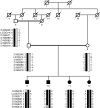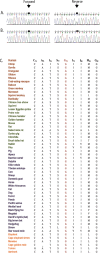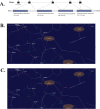Mutation in LIM2 Is Responsible for Autosomal Recessive Congenital Cataracts
- PMID: 27814360
- PMCID: PMC5096708
- DOI: 10.1371/journal.pone.0162620
Mutation in LIM2 Is Responsible for Autosomal Recessive Congenital Cataracts
Abstract
Purpose: To identify the molecular basis of non-syndromic autosomal recessive congenital cataracts (arCC) in a consanguineous family.
Methods: All family members participating in the study received a comprehensive ophthalmic examination to determine their ocular phenotype and contributed a blood sample, from which genomic DNA was extracted. Available medical records and interviews with the family were used to compile the medical history of the family. The symptomatic history of the individuals exhibiting cataracts was confirmed by slit-lamp biomicroscopy. A genome-wide linkage analysis was performed to localize the disease interval. The candidate gene, LIM2 (lens intrinsic membrane protein 2), was sequenced bi-directionally to identify the disease-causing mutation. The physical changes caused by the mutation were analyzed in silico through homology modeling, mutation and bioinformatic algorithms, and evolutionary conservation databases. The physiological importance of LIM2 to ocular development was assessed in vivo by real-time expression analysis of Lim2 in a mouse model.
Results: Ophthalmic examination confirmed the diagnosis of nuclear cataracts in the affected members of the family; the inheritance pattern and cataract development in early infancy indicated arCC. Genome-wide linkage analysis localized the critical interval to chromosome 19q with a two-point logarithm of odds (LOD) score of 3.25. Bidirectional sequencing identified a novel missense mutation, c.233G>A (p.G78D) in LIM2. This mutation segregated with the disease phenotype and was absent in 192 ethnically matched control chromosomes. In silico analysis predicted lower hydropathicity and hydrophobicity but higher polarity of the mutant LIM2-encoded protein (MP19) compared to the wild-type. Moreover, these analyses predicted that the mutation would disrupt the secondary structure of a transmembrane domain of MP19. The expression of Lim2, which was detected in the mouse lens as early as embryonic day 15 (E15) increased after birth to a level that was sustained through the postnatal time points.
Conclusion: A novel missense mutation in LIM2 is responsible for autosomal recessive congenital cataracts.
Conflict of interest statement
The authors have declared that no competing interests exist.
Figures






Similar articles
-
Missense Mutations in CRYAB Are Liable for Recessive Congenital Cataracts.PLoS One. 2015 Sep 24;10(9):e0137973. doi: 10.1371/journal.pone.0137973. eCollection 2015. PLoS One. 2015. PMID: 26402864 Free PMC article.
-
Autosomal recessive congenital cataracts linked to HSF4 in a consanguineous Pakistani family.PLoS One. 2019 Dec 9;14(12):e0225010. doi: 10.1371/journal.pone.0225010. eCollection 2019. PLoS One. 2019. PMID: 31815953 Free PMC article.
-
A Common Ancestral Mutation in CRYBB3 Identified in Multiple Consanguineous Families with Congenital Cataracts.PLoS One. 2016 Jun 21;11(6):e0157005. doi: 10.1371/journal.pone.0157005. eCollection 2016. PLoS One. 2016. PMID: 27326458 Free PMC article.
-
Reconciling genotype with phenotype: Lessons learned on the Arabian Peninsula.Ophthalmic Genet. 2017 Jan-Feb;38(1):2-6. doi: 10.1080/13816810.2016.1227457. Epub 2017 Jan 13. Ophthalmic Genet. 2017. PMID: 28085531 Review.
-
A Case of Non-Syndromic Congenital Cataracts Caused by a Novel MAF Variant in the C-Terminal DNA-Binding Domain-Case Report and Literature Review.Genes (Basel). 2024 May 25;15(6):686. doi: 10.3390/genes15060686. Genes (Basel). 2024. PMID: 38927621 Free PMC article. Review.
Cited by
-
Elongated axial length and myopia-related fundus changes associated with the Arg130Cys mutation in the LIM2 gene in four Chinese families with congenital cataracts.Ann Transl Med. 2021 Feb;9(3):235. doi: 10.21037/atm-20-4275. Ann Transl Med. 2021. PMID: 33708862 Free PMC article.
-
Fibronectin has multifunctional roles in posterior capsular opacification (PCO).Matrix Biol. 2020 Aug;90:79-108. doi: 10.1016/j.matbio.2020.02.004. Epub 2020 Mar 12. Matrix Biol. 2020. PMID: 32173580 Free PMC article.
-
Delineation of Novel Autosomal Recessive Mutation in GJA3 and Autosomal Dominant Mutations in GJA8 in Pakistani Congenital Cataract Families.Genes (Basel). 2018 Feb 20;9(2):112. doi: 10.3390/genes9020112. Genes (Basel). 2018. PMID: 29461512 Free PMC article.
-
Biallelic Variants in EPHA2 Identified in Three Large Inbred Families with Early-Onset Cataract.Int J Mol Sci. 2021 Sep 30;22(19):10655. doi: 10.3390/ijms221910655. Int J Mol Sci. 2021. PMID: 34638995 Free PMC article.
-
Structure of the lens MP20 mediated adhesive junction.bioRxiv [Preprint]. 2024 May 13:2024.05.13.594022. doi: 10.1101/2024.05.13.594022. bioRxiv. 2024. Update in: Nat Commun. 2025 Mar 26;16(1):2977. doi: 10.1038/s41467-025-57903-6. PMID: 38798449 Free PMC article. Updated. Preprint.
References
-
- Robinson GC, Jan JE, Kinnis C (1987) Congenital ocular blindness in children, 1945 to 1984 1502. Am J Dis Child 141: 1321–1324. - PubMed
-
- Merin S, Crawford JS (1971) The etiology of congenital cataracts. A survey of 386 cases. Can J Ophthalmol 6: 178–182. - PubMed
-
- Butt T, Yao W, Kaul H, Xiaodong J, Gradstein L, Zhang Y et al. (2007) Localization of autosomal recessive congenital cataracts in consanguineous Pakistani families to a new locus on chromosome 1p. Mol Vis 13: 1635–1640. - PubMed
MeSH terms
Substances
Grants and funding
LinkOut - more resources
Full Text Sources
Other Literature Sources
Medical
Molecular Biology Databases

